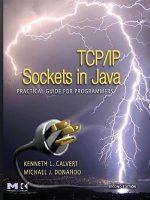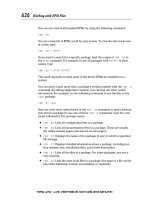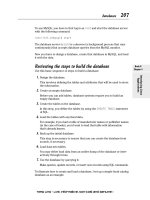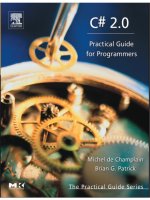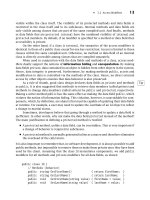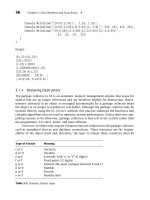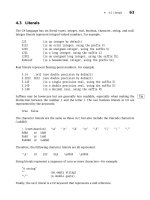TCP/IP Sockets in C# Practical Guide for Programmers phần 5 docx
Bạn đang xem bản rút gọn của tài liệu. Xem và tải ngay bản đầy đủ của tài liệu tại đây (110.06 KB, 19 trang )
64 Chapter 3: Sending and Receiving Messages
■
bits, two’s complement can represent values in the range −2
k−1
through 2
k−1
− 1, and
the most significant bit (msb) tells whether the value is positive (msb = 0) or negative
(msb = 1). On the other hand, a k-bit unsigned integer can encode values in the range
0 through 2
k
− 1 directly.
Consider again the itemNumber.Itisalong, so its binary representation is 64 bits
(8 bytes). If its value is 12345654321 and the encoding is big-endian, the 8 bytes sent
would be (with the byte on the left transmitted first):
0
223
219 188
49
002
If, on the other hand, the value was sent in little-endian order, the transmitted byte values
would be:
0
2
22321918849 00
If the sender uses big-endian when the receiver is expecting little-endian, the receiver will
end up with an itemNumber of 3583981154337816576! Most network protocols specify
big-endian byte order; in fact it is sometimes called network byte order . However, Intel-,
AMD-, and Alpha-based architectures (which are the primary architectures used by the
Microsoft Windows operating system) are by default little-endian order. If your program
will only be communicating with other C# programs on Windows operating systems, this
may not a problem. However, if you are communicating with a program using another
hardware architecture, or written in another language (e.g., Java, which uses big-endian
byte order by default), byte order can become an issue. For this reason, it is always good
form to convert outgoing multibyte binary numbers to big-endian, and incoming multibyte
binary numbers from big-endian to “local” format. This conversion capability is provided
in the .NET framework by both the IPAddress class static methods NetworkToHostOrder()
and HostToNetworkOrder(), and constructor options in the UnicodeEncoding class.
Note that the most significant bit of the 64-bit binary value of 12345654321 is 0,
so its signed (two’s-complement) and unsigned representations are the same. More gen-
erally, the distinction between k-bit signed and unsigned values is irrelevant for values
that lie in the range 0 through 2
k−1
− 1. However, protocols often use unsigned integers;
C# does provide support for unsigned integers, however, that support is not considered
CLR (Common Language Runtime) compliant. The .NET CLR was designed to provide
language portability, and therefore is restricted to using the least common denominator
of its supported languages, which does not include unsigned types. There is no immediate
drawback to using the non-CLR compliant unsigned types, other than possible cross-
language integration issues (particularly with Java/J++, which do not define unsigned
numbers as base types).
As with strings, .NET provides mechanisms to turn primitive integer types into
sequences of bytes and vice versa. In particular, the BinaryWriter class has a Write()
■
3.2 Composing I/O Streams 65
method that is overloaded to accept different type arguments, including short, int, and
long. These methods allow those types to be written out directly in two’s-complement
representation (explicit encoding needs to be specified in the BinaryWriter constructor
or manual conversion methods need to be invoked to convert the values to big-endian).
Similarly, the BinaryReader class has methods ReadInt32() (for int), ReadInt16() (for
short) and ReadInt64() (for long). The next section describes some ways to compose
instances of these classes.
3.2 Composing I/O Streams
The .NET framework’s stream classes can be composed to provide powerful encoding and
decoding facilities. For example, we can wrap the NetworkStream of a TcpClient instance in
a BufferedStream instance to improve performance by buffering bytes temporarily and
flushing them to the underlying channel all at once. We can then wrap that instance in a
BinaryWriter to send primitive data types. We would code this composition as follows:
TcpClient client = new TcpClient(server, port);
BinaryWriter out = new BinaryWriter(new BufferedStream(client.GetStream()));
Figure 3.1 demonstrates this composition. Here, we write our primitive data values, one
by one, to BinaryWriter, which writes the binary data to BufferedStream, which buffers
the data from the three writes, and then writes once to the socket NetworkStream, which
controls writing to the network. We create a identical composition with a BinaryReader on
the other endpoint to efficiently receive primitive data types.
A complete description of the .NET I/O API is beyond the scope of this text; however,
Table 3.1 provides a list of some of the relevant .NET I/O classes as a starting point for
exploiting its capabilities.
NetworkStream
NetworkStream
BufferedStream
BufferedStreamBinaryReader
BinaryWriter
ReadDouble()
ReadInt32()
ReadInt16()
Write((double)3.14)
Write((int)343)
Write((short)800)
Network
14 bytes
14 bytes
3.14
343
800
3.14
343
800
3.14 (8 bytes)
343 (4 bytes)
800 (2 bytes)
3.14 (8 bytes)
343 (4 bytes)
800 (2 bytes)
14 bytes
14 b
y
tes
Figure 3.1: Stream composition.
66 Chapter 3: Sending and Receiving Messages
■
I/O Class Function
BufferedStream Performs buffering for I/O optimization.
BinaryReader/BinaryWriter Handles read/write for primitive data types.
MemoryStream Creates streams that have memory as a backing store, and
can be used in place of temporary buffers and files.
Stream Abstract base class of all streams.
StreamReader/StreamWriter Read and write character input/output to/from a stream in
a specified encoding.
StringReader/StringWriter Read and write character input/output to/from a string in a
specified encoding.
TextReader/TextWriter Abstract base class for reading and writing character
input/output. Base class of StreamReader/Writer and
StringReader/Writer.
Table 3.1: .NET I/O Classes
3.3 Framing and Parsing
Converting data to wire format is, of course, only half the story; the original information
must be recovered at the receiver from the transmitted sequence of bytes. Application
protocols typically deal with discrete messages, which are viewed as collections of fields.
Framing refers to the problem of enabling the receiver to locate the beginning and end
of the message in the stream and of the fields within the message. Whether information
is encoded as text, as multibyte binary numbers, or as some combination of the two,
the application protocol must enable the receiver of a message to determine when it has
received all of the message and to parse it into fields.
If the fields in a message all have fixed sizes and the message is made up of a fixed
number of fields, then the size of the message is known in advance and the receiver can
simply read the expected number of bytes into a byte[ ] buffer. This technique was used
in TCPEchoClient.cs, where we knew the number of bytes to expect from the server.
However, when some field (and/or the whole message) can vary in length, as with the
itemDescription in our example, we do not know beforehand how many bytes to read.
Marking the end of the message is easy in the special case of the last message to be
sent on a TCP connection: the sender simply closes the sending side of the connection
(using Shutdown(SocketShutdown.Send)
1
or Close()) after sending the message. After the
receiver reads the last byte of the message, it receives an end-of-stream indication (i.e.,
Read() returns 0), and thus can tell that it has as much of the message as there will ever be.
The same principle applies to the last field in a message sent as a UDP datagram packet.
1
The Shutdown() method is only available in .NET in the Socket class. See Section 4.6 for a mechanism
to utilize this functionality for .NET’s higher level socket classes as well.
■
3.3 Framing and Parsing 67
In all other cases, the message itself must contain additional framing information
enabling the receiver to parse the field/message. This information typically takes one of
the following forms:
■
Delimiter: The end of the variable-length field or message is indicated by a unique
marker, an explicit byte sequence that immediately follows, but does not occur in,
the data.
■
Explicit length: The variable-length field or message is preceded by a (fixed-size)
length field that tells how many bytes it contains.
The delimiter-based approach is often used with variable-length text: A particular
character or sequence of characters is defined to mark the end of the field. If the entire
message consists of text, it is straightforward to read in characters using an instance of
a TextReader (which handles the byte-to-character translation), looking for the delimiter
sequence, and returning the character string preceding it.
Unfortunately, the TextReader classes do not support reading binary data. Moreover,
the relationship between the number of bytes read from the underlying NetworkStream
and the number of characters read from the TextReader is unspecified, especially with
multibyte encodings. When a message uses a combination of the two framing methods
mentioned above, with some explicit-length-delimited fields and others using character
markers, this can create problems.
The class Framer, defined below, allows NetworkStream to be parsed as a sequence
of fields delimited by specific byte patterns. The static method Framer.nextToken() reads
bytes from the given Stream until it encounters the given sequence of bytes or the stream
ends. All bytes read up to that point are then returned in a new byte array. If the end of
the stream is encountered before any data is read, null is returned. The delimiter can be
different for each call to nextToken(), and the method is completely independent of any
encoding.
A couple of words of caution are in order here. First, nextToken() is terribly ineffi-
cient; for real applications, a more efficient pattern-matching algorithm should be used.
Second, when using Framer.nextToken() with text-based message formats, the caller must
convert the delimiter from a character string to a byte array and the returned byte array
to a character string. In this case the character encoding needs to distribute over concate-
nation, so that it doesn’t matter whether a string is converted to bytes all at once or a little
bit at a time.
To make this precise, let E( ) represent an encoding—that is, a function that maps
character sequences to byte sequences. Let a and b be sequences of characters, so E(a)
denotes the sequence of bytes that is the result of encoding a. Let “+” denote con-
catenation of sequences, so a + b is the sequence consisting of a followed by b. This
explicit-conversion approach (as opposed to parsing the message as a character stream)
should only be used with encodings that have the property that E(a + b) = E(a) + E(b); other-
wise, the results may be unexpected. Although most encodings supported in .NET have
this property, some do not. In particular, the big- and little-endian versions of Unicode
68 Chapter 3: Sending and Receiving Messages
■
encode a String by first outputting a byte-order indicator (the 2-byte sequence 254–255
for big-endian, and 255–254 for little-endian), followed by the 16-bit Unicode value of each
character in the String, in the indicated byte order. Thus, the encoding of “Big fox” using
big-endian Unicode with a byte-order marker is as follows:
254
255 0
66
0
105 0
103
0032
111
102
0
0
120
[
mark
]
'B' 'i' '
g
' ' ' 'f' 'o' 'x'
The encoding, on the other hand, of “Big” concatenated with the encoding of “fox,” using
the same encoding, is as follows:
254 254255 2550 66 0 105 0 103 0 032 111102 00 120
[
mark
]
'x'
[
mark
]
'B' 'i' '
g
' ' ' 'f' 'o'
Using either of these encodings to convert the delimiter results in a byte sequence
that begins with the byte-order marker. The encodings BigEndianUnicode and Unicode
(little-endian) omit the byte-order marker, and the UnicodeEncoding class omits it unless
specified otherwise in the constructor, so they are suitable for use with Framer.
nextToken().
Framer.cs
0 using System; // For Boolean
1 using System.IO; // For Stream
2
3 public class Framer {
4
5 public static byte[] nextToken(Stream input, byte[] delimiter) {
6 int nextByte;
7
8 // If the stream has already ended, return null
9 if ((nextByte = input.ReadByte()) == -1)
10 return null;
11
12 MemoryStream tokenBuffer = new MemoryStream();
13 do {
14 tokenBuffer.WriteByte((byte)nextByte);
15 byte[] currentToken = tokenBuffer.ToArray();
16 if (endsWith(currentToken, delimiter)) {
■
3.3 Framing and Parsing 69
17 int tokenLength = currentToken.Length - delimiter.Length;
18 byte[] token = new byte[tokenLength];
19 Array.Copy(currentToken, 0, token, 0, tokenLength);
20 return token;
21 }
22 } while ((nextByte = input.ReadByte()) != -1); // Stop on EOS
23 return tokenBuffer.ToArray(); // Received at least one byte
24 }
25
26 // Returns true if value ends with the bytes in the suffix
27 private static Boolean endsWith(byte[] value, byte[] suffix) {
28 if (value.Length < suffix.Length)
29 return false;
30
31 for (int offset=1; offset <= suffix.Length; offset++)
32 if (value[value.Length - offset] != suffix[suffix.Length - offset])
33 return false;
34
35 return true;
36 }
37 }
Framer.cs
1. nextToken(): lines 5–24
Read from input stream until delimiter or end-of-stream.
■
Test for end-of-stream: lines 8–10
If the input stream is already at end-of-stream, return null.
■
Create a buffer to hold the bytes of the token: line 12
We use a MemoryStream to collect the data byte by byte. The MemoryStream class
allows a byte array to be handled like a stream of bytes.
■
Put the last byte read into the buffer: line 14
■
Get a byte array containing the input so far: line 15
It is very inefficient to create a new byte array on each iteration, but it is simple.
■
Check whether the delimiter is a suffix of the current token: lines 16–21
If so, create a new byte array containing the bytes read so far, minus the delimiter
suffix, and return it.
■
Get next byte: line 22
■
Return the current token on end-of-stream: line 23
70 Chapter 3: Sending and Receiving Messages
■
2. endsWith(): lines 26–36
■
Compare lengths: lines 28–29
The candidate sequence must be at least as long as the delimiter to be a match.
■
Compare bytes, return false on any difference: lines 31–33
Compare the last suffix.Length bytes of the token to the delimiter.
■
If no difference, return true: line 35
3.4 Implementing Wire Formats in C#
To emphasize the fact that the same information can be represented “on the wire” in differ-
ent ways, we define an interface ItemQuoteEncoder, which has a single method that takes
an ItemQuote instance and converts it to a byte[ ] that can be written to a NetworkStream
or sent as is for datagrams or direct Sockets.
ItemQuoteEncoder.cs
0 public interface ItemQuoteEncoder {
1 byte[] encode(ItemQuote item);
2 }
ItemQuoteEncoder.cs
The specification of the corresponding decoding functionality is given by the
ItemQuoteDecoder interface, which has methods for parsing messages received via streams
or in byte arrays used for UDP packets. Each method performs the same function: extract-
ing the information for one message and returning an ItemQuote instance containing the
information.
ItemQuoteDecoder.cs
0 using System.IO; // For Stream
1
2 public interface ItemQuoteDecoder {
3 ItemQuote decode(Stream source);
4 ItemQuote decode(byte[] packet);
5 }
ItemQuoteDecoder.cs
Sections 3.4.1 and 3.4.2 present two different implementations for these interfaces: one
using a text representation, the other, a hybrid encoding.
■
3.4 Implementing Wire Formats in C# 71
3.4.1 Text-Oriented Representation
Clearly we can represent the ItemQuote information as text. One possibility is simply to
transmit the output of the ToString() method using a suitable character encoding. To
simplify parsing, the approach in this section uses a different representation, in which
the values of itemNumber, itemDescription, and so on are transmitted as a sequence of
delimited text fields. The sequence of fields is as follows:
Item NumberDescriptionQuantityPriceDiscount?In Stock?
The Item Number field (and the other integer-valued fields, Quantity and Price) contain
a sequence of decimal-digit characters followed by a space character (the delimiter). The
Description field is just the description text. However, because the text itself may include
the space character, we have to use a different delimiter; we choose the newline character,
represented as \n in C#, as the delimiter for this field.
Boolean values can be encoded in several different ways. Although a single-byte
Boolean is one of the overloaded arguments in the BinaryWriter Write() method, in order
to keep our wire format slightly more language agnostic (and to allow it to communicate
with the Java versions of these programs [25]) we opted not to use it. Another possibility is
to include the string “ true” or the string “ false,” according to the value of the variable. A
more compact approach (and the one used here) is to encode both values (discounted and
inStock) in a single field; the field contains the character ‘d’ if discounted is true, indicating
that the item is discounted, and the character ‘s’ if inStock is true, indicating that the item
is in stock. The absence of a character indicates that the corresponding Boolean is false,
so this field may be empty. Again, a different delimiter (\n) is used for this final field, to
make it slightly easier to recognize the end of the message even when this field is empty.
A quote for 23 units of item number 12345, which has the description “AAA Battery” and
a price of $14.45, and which is both in stock and discounted, would be represented as
12345 AAA Battery\n23 1445 ds\n
Constants needed by both the encoder and the decoder are defined in the ItemQuote-
TextConst interface, which defines “ascii” as the default encoding (we could just as easily
have used any other encoding as the default) and 1024 as the maximum length (in bytes)
of an encoded message. Limiting the length of an encoded message limits the flexibility of
the protocol, but it also provides for sanity checks by the receiver.
ItemQuoteTextConst.cs
0 using System; // For String
1
2 public class ItemQuoteTextConst {
3 public static readonly String DEFAULT_CHAR_ENC = "ascii";
4 public static readonly int MAX_WIRE_LENGTH = 1024;
5 }
ItemQuoteTextConst.cs
72 Chapter 3: Sending and Receiving Messages
■
ItemQuoteEncoderText implements the text encoding.
ItemQuoteEncoderText.cs
0 using System; // For String, Activator
1 using System.IO; // For IOException
2 using System.Text; // For Encoding
3
4 public class ItemQuoteEncoderText : ItemQuoteEncoder {
5
6 public Encoding encoding; // Character encoding
7
8 public ItemQuoteEncoderText() : this(ItemQuoteTextConst.DEFAULT_CHAR_ENC) {
9 }
10
11 public ItemQuoteEncoderText(string encodingDesc) {
12 encoding = Encoding.GetEncoding(encodingDesc);
13 }
14
15 public byte[] encode(ItemQuote item) {
16
17 String EncodedString = item.itemNumber+"";
18 if (item.itemDescription.IndexOf(’\n’) != -1)
19 throw new IOException("Invalid description (contains newline)");
20 EncodedString = EncodedString + item.itemDescription + "\n";
21 EncodedString = EncodedString + item.quantity+"";
22 EncodedString = EncodedString + item.unitPrice+"";
23
24 if (item.discounted)
25 EncodedString = EncodedString + "d"; // Only include ’d’ if discounted
26 if (item.inStock)
27 EncodedString = EncodedString + "s"; // Only include ’s’ if in stock
28 EncodedString = EncodedString + "\n";
29
30 if (EncodedString.Length > ItemQuoteTextConst.MAX_WIRE_LENGTH)
31 throw new IOException("Encoded length too long");
32
33 byte[] buf = encoding.GetBytes(EncodedString);
34
■
3.4 Implementing Wire Formats in C# 73
35 return buf;
36
37 }
38 }
ItemQuoteEncoderText.cs
1. Constructors: lines 8–13
If no encoding is explicitly specified, we use the default encoding specified in the con-
stant interface. The Encoding class method GetEncoding() takes a string argument
that specifies the encoding to use, in this case the default is the constant “ascii” from
ItemQuoteTextConst.cs.
2. encode() method: lines 15–37
■
Write the first integer, followed by a space delimiter: line 17
■
Check for delimiter: lines 18–19
Make sure that the field delimiter is not contained in the field itself. If it is, throw
an exception.
■
Output itemDescription and other integers: lines 20–22
■
Write the flag characters if the Booleans are true: lines 24–27
■
Write the delimiter for the flag field: line 28
■
Validate that the encoded length is within the maximum size limit:
lines 30–31
■
Convert the encoded string from the given encoding to a byte array: line 33
■
Return the byte array: line 35
The decoding class ItemQuoteDecoderText simply inverts the encoding process.
ItemQuoteDecoderText.cs
0 using System; // For String, Activator
1 using System.Text; // For Encoding
2 using System.IO; // For Stream
3
4 public class ItemQuoteDecoderText : ItemQuoteDecoder {
5
6 public Encoding encoding; // Character encoding
7
8 public ItemQuoteDecoderText() : this (ItemQuoteTextConst.DEFAULT_CHAR_ENC) {
9 }
74 Chapter 3: Sending and Receiving Messages
■
10
11 public ItemQuoteDecoderText(String encodingDesc) {
12 encoding = Encoding.GetEncoding(encodingDesc);
13 }
14
15 public ItemQuote decode(Stream wire) {
16 String itemNo, description, quant, price, flags;
17
18 byte[] space = encoding.GetBytes(" ");
19 byte[] newline = encoding.GetBytes("\n");
20
21 itemNo = encoding.GetString(Framer.nextToken(wire, space));
22 description = encoding.GetString(Framer.nextToken(wire, newline));
23 quant = encoding.GetString(Framer.nextToken(wire, space));
24 price = encoding.GetString(Framer.nextToken(wire, space));
25 flags = encoding.GetString(Framer.nextToken(wire, newline));
26
27 return new ItemQuote(Int64.Parse(itemNo), description,
28 Int32.Parse(quant),
29 Int32.Parse(price),
30 (flags.IndexOf(’d’) != -1),
31 (flags.IndexOf(’s’) != -1));
32 }
33
34 public ItemQuote decode(byte[] packet) {
35 Stream payload = new MemoryStream(packet, 0, packet.Length, false);
36 return decode(payload);
37 }
38 }
ItemQuoteDecoderText.cs
1. Variables and constructors: lines 6–13
■
Encoding: line 6
The encoding used in the decoder must be the same as in the encoder!
■
Constructors: lines 8–13
If no encoding is given at construction time, the default defined in ItemQuote-
TextConst is used.
2. Stream decode(): lines 15–32
■
Convert delimiters: lines 18–19
We get the encoded form of the delimiters ahead of time, for efficiency.
■
3.4 Implementing Wire Formats in C# 75
■
Call the nextToken() method for each field: lines 21–25
For each field, we call Framer.nextToken() with the appropriate delimiter and
convert the result according to the specified encoding.
■
Construct ItemQuote: lines 27–31
Convert to native types using the wrapper conversion methods and test for the
presence of the flag characters in the last field.
3. Byte array decode(): lines 34–37
For UDP packets, convert the byte array to a stream, and then call the stream decode()
method.
3.4.2 Combined Data Representation
Our next encoding represents the integers of the ItemQuote as fixed-size, binary numbers:
itemNumber as 64 bits, and quantity and unitPrice as 32 bits. It encodes the Boolean values
as flag bits, which occupy the smallest possible space in an encoded message. Also, the
variable-length string itemDescription is encoded in a field with an explicit length indica-
tion. The binary encoding and decoding share coding constants in the ItemQuoteBinConst
interface.
ItemQuoteBinConst.cs
0 using System; // For String
1
2 public class ItemQuoteBinConst {
3 public static readonly String DEFAULT_CHAR_ENC = "ascii";
4
5 public static readonly byte DISCOUNT_FLAG=1<<7;
6 public static readonly byte IN_STOCK_FLAG=1<<0;
7 public static readonly int MAX_DESC_LEN = 255;
8 public static readonly int MAX_WIRE_LENGTH = 1024;
9 }
ItemQuoteBinConst.cs
ItemQuoteEncoderBin implements the binary encoding.
ItemQuoteEncoderBin.cs
0 using System; // For String, Activator
1 using System.IO; // For BinaryWriter
2 using System.Text; // For Encoding
3 using System.Net; // For IPAddress
76 Chapter 3: Sending and Receiving Messages
■
4
5 public class ItemQuoteEncoderBin : ItemQuoteEncoder {
6
7 public Encoding encoding; // Character encoding
8
9 public ItemQuoteEncoderBin() : this (ItemQuoteBinConst.DEFAULT_CHAR_ENC) {
10 }
11
12 public ItemQuoteEncoderBin(String encodingDesc) {
13 encoding = Encoding.GetEncoding(encodingDesc);
14 }
15
16 public byte[] encode(ItemQuote item) {
17
18 MemoryStream mem = new MemoryStream();
19 BinaryWriter output = new BinaryWriter(new BufferedStream(mem));
20
21 output.Write(IPAddress.HostToNetworkOrder(item.itemNumber));
22 output.Write(IPAddress.HostToNetworkOrder(item.quantity));
23 output.Write(IPAddress.HostToNetworkOrder(item.unitPrice));
24
25 byte flags = 0;
26 if (item.discounted)
27 flags |= ItemQuoteBinConst.DISCOUNT_FLAG;
28 if (item.inStock)
29 flags |= ItemQuoteBinConst.IN_STOCK_FLAG;
30 output.Write(flags);
31
32 byte[] encodedDesc = encoding.GetBytes(item.itemDescription);
33 if (encodedDesc.Length > ItemQuoteBinConst.MAX_DESC_LEN)
34 throw new IOException("Item Description exceeds encoded length limit");
35 output.Write((byte)encodedDesc.Length);
36 output.Write(encodedDesc);
37
38 output.Flush();
39
40 return mem.ToArray();
41 }
42 }
ItemQuoteEncoderBin.cs
■
3.4 Implementing Wire Formats in C# 77
1. Constants, variables, and constructors: lines 7–14
2. encode(): lines 16–41
■
Set up Output: lines 18–19
A MemoryStream collects the bytes of the encoded message. Encapsulating the
MemoryStream in a BinaryWriter allows the use of its methods for writing binary
integers.
■
Write integers: lines 21–23
The Write() method is overloaded to write all of the basic C# data types. The static
IPAddress.HostToNetworkOrder() method converts each integer to big-endian
order, and is also overloaded to accept longs, ints, and shorts, and returns the
same size integer as it was passed.
■
Write Booleans as flags: lines 25–30
Encode each Boolean using a single bit in a flag byte. Initialize the flag byte to 0,
then set the appropriate bits to 1, if either discounted or inStock is true. (The bits
are defined in the ItemQuoteBinConst interface to be the most and least significant
bits of the byte, respectively.) Write the byte to the stream.
■
Convert description string to bytes: line 32
Convert the text to bytes in the specified encoding.
■
Check description length: lines 33–34
We are going to use an explicit length encoding for the string, with a single byte
giving the length. The biggest value that byte can contain is 255 bytes, so the
length of the encoded string must not exceed 255 bytes. If it does, we throw an
exception.
■
Write encoded string: lines 35–36
Write the length of the encoded string, followed by the bytes in the buffer.
■
Flush output stream, return bytes: line 38
Ensure that all bytes are flushed from the MemoryStream to the underlying byte
buffer.
■
Return the byte array to be sent: line 40
ItemQuoteDecoderBin implements the corresponding decoder function.
ItemQuoteDecoderBin.cs
0 using System; // For String, Activator
1 using System.IO; // For Stream
2 using System.Text; // For Encoding
3 using System.Net; // For IPAddress
4
5 public class ItemQuoteDecoderBin : ItemQuoteDecoder {
6
78 Chapter 3: Sending and Receiving Messages
■
7 public Encoding encoding; // Character encoding
8
9 public ItemQuoteDecoderBin() : this (ItemQuoteTextConst.DEFAULT_CHAR_ENC) {
10 }
11
12 public ItemQuoteDecoderBin(String encodingDesc) {
13 encoding = Encoding.GetEncoding(encodingDesc);
14 }
15
16 public ItemQuote decode(Stream wire) {
17 BinaryReader src = new BinaryReader(new BufferedStream(wire));
18
19 long itemNumber = IPAddress.NetworkToHostOrder(src.ReadInt64());
20 int quantity = IPAddress.NetworkToHostOrder(src.ReadInt32());
21 int unitPrice = IPAddress.NetworkToHostOrder(src.ReadInt32());
22 byte flags = src.ReadByte();
23
24 int stringLength = src.Read(); // Returns an unsigned byte as an int
25 if (stringLength == -1)
26 throw new EndOfStreamException();
27 byte[] stringBuf = new byte[stringLength];
28 src.Read(stringBuf, 0, stringLength);
29 String itemDesc = encoding.GetString(stringBuf);
30
31 return new ItemQuote(itemNumber,itemDesc, quantity, unitPrice,
32
((flags & ItemQuoteBinConst.DISCOUNT_FLAG) == ItemQuoteBinConst.DISCOUNT_FLAG),
33 ((flags & ItemQuoteBinConst.IN_STOCK_FLAG) == ItemQuoteBinConst.IN_STOCK_FLAG));
34 }
35
36 public ItemQuote decode(byte[] packet) {
37 Stream payload = new MemoryStream(packet, 0, packet.Length, false);
38 return decode(payload);
39 }
40 }
ItemQuoteDecoderBin.cs
1. Constants, variables, and constructors: lines 7–14
2. Stream decode: lines 16–34
■
3.4 Implementing Wire Formats in C# 79
■
Wrap the input Stream: line 17
Using the given Stream, construct a BinaryReader so we can make use of the methods
readInt64(), readInt32(), and readByte() for reading binary data types from the
input.
■
Read integers: lines 19–21
Read the integers back in the same order in which they were written out. The
readInt64() method reads 8 bytes (64 bits) and constructs a (signed) long. The
readInt32() method reads 4 bytes and constructs a (signed) int. The static method
IPAddress.NetworkToHostOrder() converts from big-endian (network) byte order-
ing to the host’s native byte ordering; if the native ordering is big-endian, the data
is returned unmodified. Either will throw an EndOfStreamException if the stream
ends before the requisite number of bytes is read.
■
Read flag byte: line 22
The flag byte is next; the values of the individual bits will be checked later.
■
Read string length: lines 24–26
The next byte contains the length of the encoded string. Note that we use the Read()
method, which returns the contents of the next byte read as an integer between 0
and 255, and that we read it into an int.
■
Allocate buffer and read encoded string: lines 27–29
Once we know how long the encoded string is, we allocate a buffer and call
Read() specifying the expected number of bytes. Read() will throw an EndOfStream-
Exception if the stream ends before the buffer is filled. Note the advantage of
the length-prefixed String representation: bytes do not have to be interpreted as
characters until you have them all.
■
Check flags: lines 32–33
The expressions used as parameters in the call to the constructor illustrate the stan-
dard method of checking whether a particular bit is set (equal to 1) in an integer type.
3. Byte array decode: lines 36–39
Simply wrap the packet’s byte array in a MemoryStream and pass to the stream-decoding
method.
3.4.3 Sending and Receiving
The encodings presented above can be used with both the NetworkStreams of .NET’s
TcpClient and TcpListener, and with the byte arrays of the UdpClient class. We show
the TCP usage first.
SendTcp.cs
0 using System; // For String, Console, ArgumentException
1 using System.Net.Sockets; // For TcpClient, NetworkStream
2
80 Chapter 3: Sending and Receiving Messages
■
3 class SendTcp {
4
5 static void Main(string[] args) {
6
7 if (args.Length != 2) // Test for correct # of args
8 throw new ArgumentException("Parameters: <Destination> <Port>");
9
10 String server = args[0]; // Destination address
11 int servPort = Int32.Parse(args[1]); // Destination port
12
13 // Create socket that is connected to server on specified port
14 TcpClient client = new TcpClient(server, servPort);
15 NetworkStream netStream = client.GetStream();
16
17 ItemQuote quote = new ItemQuote(1234567890987654L, "5mm Super Widgets",
18 1000, 12999, true, false);
19
20 // Send text-encoded quote
21 ItemQuoteEncoderText coder = new ItemQuoteEncoderText();
22 byte[] codedQuote = coder.encode(quote);
23 Console.WriteLine("Sending Text-Encoded Quote (" +
24 codedQuote.Length + " bytes): ");
25 Console.WriteLine(quote);
26
27 netStream.Write(codedQuote, 0, codedQuote.Length);
28
29 // Receive binary-encoded quote
30 ItemQuoteDecoder decoder = new ItemQuoteDecoderBin();
31 ItemQuote receivedQuote = decoder.decode(client.GetStream());
32 Console.WriteLine("Received Binary-Encode Quote:");
33 Console.WriteLine(receivedQuote);
34
35 netStream.Close();
36 client.Close();
37 }
38 }
SendTcp.cs
1. TcpClient setup: lines 13–15
2. Send using text encoding: lines 20–27
3. Receive using binary encoding: lines 29–33
■
3.4 Implementing Wire Formats in C# 81
RecvTcp.cs
0 using System; // For Console, Int32, ArgumentException
1 using System.Net; // For IPAddress
2 using System.Net.Sockets; // For TcpListener, TcpClient
3
4 class RecvTcp {
5
6 static void Main(string[] args) {
7
8 if (args.Length != 1) // Test for correct # of args
9 throw new ArgumentException("Parameters: <Port>");
10
11 int port = Int32.Parse(args[0]);
12
13 // Create a TCPListener to accept client connections
14 TcpListener listener = new TcpListener(IPAddress.Any, port);
15 listener.Start();
16
17 TcpClient client = listener.AcceptTcpClient(); // Get client connection
18
19 // Receive text-encoded quote
20 ItemQuoteDecoder decoder = new ItemQuoteDecoderText();
21 ItemQuote quote = decoder.decode(client.GetStream());
22 Console.WriteLine("Received Text-Encoded Quote:");
23 Console.WriteLine(quote);
24
25 // Repeat quote with binary-encoding, adding 10 cents to the price
26 ItemQuoteEncoder encoder = new ItemQuoteEncoderBin();
27 quote.unitPrice += 10; // Add 10 cents to unit price
28 Console.WriteLine("Sending (binary) ");
29 byte[] bytesToSend = encoder.encode(quote);
30 client.GetStream().Write(bytesToSend, 0, bytesToSend.Length);
31
32 client.Close();
33 listener.Stop();
34 }
35 }
RecvTcp.cs
1. TcpListener setup: lines 13–15
2. Accept client connection: line 17
82 Chapter 3: Sending and Receiving Messages
■
3. Receive and print out a text-encoded message: lines 19–23
4. Send a binary-encoded message: lines 25–30
Note that before sending, we add 10 cents to the unit price given in the original
message.
To demonstrate the use of the encoding and decoding classes with datagrams, we
include a simple UDP sender and receiver. Since this is very similar to the TCP code, we do
not include any code description.
SendUdp.cs
0 using System; // For String, Int32, ArgumentException
1 using System.Net.Sockets; // For UdpClient
2
3 class SendUdp {
4
5 static void Main(string[] args) {
6
7 if (args.Length != 2 && args.Length != 3) // Test for correct # of args
8 throw new ArgumentException("Parameter(s): <Destination>" +
9 " <Port> [<encoding]");
10
11 String server = args[0]; // Server name or IP address
12 int destPort = Int32.Parse(args[1]); // Destination port
13
14 ItemQuote quote = new ItemQuote(1234567890987654L, "5mm Super Widgets",
15 1000, 12999, true, false);
16
17 UdpClient client = new UdpClient(); // UDP socket for sending
18
19 ItemQuoteEncoder encoder = (args.Length == 3 ?
20 new ItemQuoteEncoderText(args[2]) :
21 new ItemQuoteEncoderText());
22
23 byte[] codedQuote = encoder.encode(quote);
24
25 client.Send(codedQuote, codedQuote.Length, server, destPort);
26
27 client.Close();
28 }
29 }
SendUdp.cs

